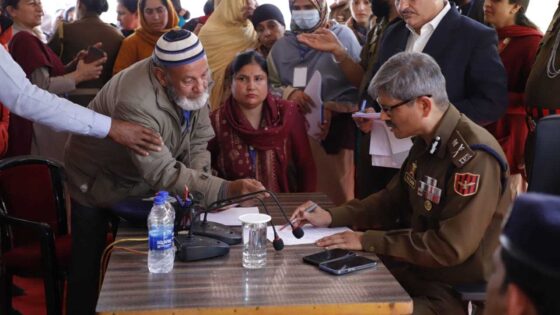The prevalence of cardiovascular diseases, such as heart attacks, appears to have been increasing in Kashmir for quite some time. Sadly, almost every week witness the untimely demise of a young person due to a heart attack. This alarming trend not only instils fear among the general public but has also emerged as a significant concern for scientists and medical professionals. Observations suggest that the majority of casualties are young males rather than females. However, is it accurate to assert that the incidence of heart attacks in Kashmir has surged in recent years? Is there conclusive evidence from studies to substantiate this claim? Well, I’ll have to get back to you on that. First, let’s establish a consensus on what qualifies as a heart attack.
Understanding a Heart Attack?
Blocking or significantly reducing blood flow to the heart leads to a heart attack or myocardial infarction. In most cases, obstructed coronary arteries arise from the accumulation of fatty deposits, cholesterol, and other substances. The term “plaques” is used to describe these fatty, cholesterol-filled deposits, while “atherosclerosis” denotes the process of plaque buildup. If a plaque ruptures, it can trigger the formation of a clot, limiting blood flow. Inadequate blood supply can result in permanent injury or death to a segment of the heart muscle.
What Causes It?
Most heart attacks are triggered by coronary artery disease, wherein the blockage of one or more coronary arteries occurs. These blockages, referred to as plaques, are typically composed of cholesterol. The accumulation of plaques can restrict blood flow to the heart. If a plaque ruptures, it may result in the formation of a blood clot, leading to a heart attack.
The complete or partial blockage of a coronary artery can induce a heart attack. Electrocardiogram (ECG) findings, which signal the necessity for immediate invasive treatment, can be utilized to classify heart attacks. An expert may use the results of an electrocardiogram (ECG) to delineate various types of heart attacks.
Myocardial infarction with ST-segment elevation (STEMI) or unstable angina pectoris (AIS) represents the most common outcome of a sudden, total obstruction in a medium- or large-sized coronary artery. Non-ST-elevation myocardial infarction is frequently linked to partial occlusion (NSTEMI). Nevertheless, a subset of patients with NSTEMI exhibits a complete blockage.
It’s crucial to note that blocked arteries are not the exclusive cause of heart attacks. Another possible reason is the significant constriction of an otherwise unblocked blood channel, as is the case with coronary artery spasms. Common causes of this condition include cholesterol plaques or early arterial hardening due to smoking or other risk factors. When spasms in the coronary arteries lead to angina, it is also known as Prinzmetal’s angina, vasospastic angina, or variant angina.
Heart muscle damage and the potentially fatal disorder of spontaneous coronary artery dissection (SCAD) can be triggered by viral infections such as COVID-19 and others.
Are There Any Risk Factors?
Certainly, multiple risk factors contribute to Cardiovascular Diseases (CVDs), including heart attacks. One such risk factor is old age. It is believed that the likelihood of experiencing a heart attack rises with age, with males aged 45 and older and females aged 55 and older being more vulnerable than their counterparts under the age of 45 and 55, respectively. Cigarette smoking and hypertension are two additional contributors.
Another factor, high blood pressure, can lead to permanent damage to the heart’s arteries over time. Having hypertension, along with being overweight, having high cholesterol, or being diabetic, significantly increases the risk.
A similar phenomenon occurs when there is an excess of low-density lipoprotein (LDL) cholesterol, commonly referred to as “bad cholesterol.” Triglycerides, a type of blood fat, significantly increase the risk of a heart attack when present in high concentrations. If levels of high-density lipoprotein (HDL) cholesterol, sometimes known as “good cholesterol,” are within the normal range, a person may be at a lower risk of experiencing a heart attack.
Likewise, a person might be at a higher risk if a sibling, parent, or grandmother experienced a heart attack before the age of 55 (for men) or 65 (for women). The association between inactivity (a sedentary lifestyle) and cardiovascular disease remains consistent. Regular exercise can enhance the health of your heart.
Heart disease is associated with a diet rich in animal fats, sweets, processed foods, trans fats, and salt. Increasing your intake of healthful foods, such as fruits, vegetables, fiber, and healthy oils, is recommended.
Obesity has been linked to a variety of health problems, including diabetes, hypertension, elevated levels of bad cholesterol and triglycerides, and decreased levels of good HDL cholesterol. If a person has diabetes, special caution should be exercised. When insulin production is inadequate, or its effects are blocked, blood sugar levels rise. Therefore, consistently high blood sugar may lead to the risk of experiencing a heart attack.
The use of illegal drugs like cocaine or amphetamines and experiencing excessive emotional stress can elevate the risk of a heart attack. It’s important to remember that the constriction of coronary arteries might trigger a heart attack.
How To Tell It is An Heart Attack?
Keep in mind that symptoms and indicators can vary from person to person. Be aware that some individuals may experience no symptoms at all. Common symptoms include severe chest pain causing tightness in the chest, which may radiate to the back, jaw, neck, and arms. Additionally, symptoms may include cold sweats, dizziness, general exhaustion, shortness of breath, and heartburn.
At times, heart attacks occur suddenly; however, many people experience symptoms and indicators hours, days, or weeks before a serious event. Frequent, severe chest discomfort or pressure (angina) that does not improve with rest should be taken seriously. Temporary reductions in blood supply to the heart are the direct cause of angina.
Heart Attacks: The Global Scenario?
Cardiovascular Diseases (CVDs) stand as the leading cause of death globally. According to data released by the World Health Organization (WHO), 17.9 million people die each year from CVD, accounting for an estimated 32 percent of global deaths. Simultaneously, WHO data indicates that over 75 percent of these CVD-related deaths occur in low- and middle-income countries. This provides an overall understanding of why countries like India or regions like Kashmir may exhibit higher incidences of heart attacks. Furthermore, WHO estimates, based on data, reveal that 85 percent of all CVD deaths result from strokes and heart attacks. The data itself serves as clear evidence of the severity of heart attacks and strokes within the realm of CVDs.
The American Heart Association (AHA) also published extensive data on Cardiovascular Diseases (CVDs), revealing that in the United States alone, 868,662 people passed away in 2017 due to CVDs. Additionally, CVD stands as the leading cause of death worldwide, claiming more lives annually than all forms of cancer and Chronic Lower Respiratory Disease (CLRD) combined. According to the American Heart Association (AHA), between 2015 and 2018, an estimated 126.9 million adult Americans had at least one type of CVD. Despite the United States being one of the world’s most developed nations, the total expenses for CVD in 2016–2017 amounted to $363.4 billion. In 2018, Coronary Heart Disease (CHD) accounted for 42.1% of all CVD-related deaths in the United States, followed by stroke (17%), hypertension (11%), heart failure (9.6%), vascular disease (2.9%), and other CVD (1.7%). About 18.6 million deaths worldwide are attributed to cardiovascular disease this year. Furthermore, in 2014 and 2015, CVD and stroke accounted for 13% of overall healthcare costs, surpassing the total number of diagnoses made by any major organization.
The Indian Scenario
In recent years, Cardiovascular Diseases (CVDs) have surpassed other causes of death in India, accounting for 25% of all deaths. Over eighty percent of all cardiovascular disease-related deaths can be attributed to ischemic heart disease and stroke. According to the Global Burden of Disease Report, India’s age-standardized CVD death rate is 272 per 100,000 people, exceeding the global average of 235 per 100,000 people. Particularly worrisome aspects of the CVD epidemic in India include its rapid growth, the young age at which it appears in the population, and the high case fatality rate. This epidemiological shift from infectious to chronic diseases has occurred swiftly in India. Premature death due to CVD increased by 59% in India, from 23.2 million (1990) to 37 million (2005), measured by the number of years of potential life lost (2010). CVD has emerged as the major cause of mortality throughout all regions of India, including poorer states and rural areas, despite substantial variation in the incidence of cardiovascular risk factors across different regions. As the epidemic has progressed, tobacco smoking and inadequate consumption of fruits and vegetables have become increasingly common among those of lower socioeconomic status. Furthermore, individuals from lower socioeconomic backgrounds are less likely to receive adequate therapy, leading to worse outcomes. Strategies are needed to combat the pandemic, including the development and successful implementation of evidence-based policies, the strengthening of health systems, and a focus on prevention, early identification, and treatment using both conventional and new methods. It’s important to reiterate that India is a developing country, and consequently, its rate of cardiovascular diseases is higher than the global average.
The Kashmir Scenario
The uncertainty surrounding whether the increase in Cardiovascular Diseases (CVDs) is unique to the region or comparable to other Indian states persists due to limited research in this area. Consequently, a team of researchers conducted a study on CVDs in two Kashmiri regions. The current prevalence of Coronary Heart Disease (CHD) is notably high and increasing across the Indian subcontinent. Similar to other emerging communities, the people of Jammu and Kashmir are adapting to new ways of life. However, the unique stress and pressures of the past 15 years, stemming from the disturbing situation in the state, seem to have contributed to the rising prevalence of CHD.
To compare CHD rates between rural and urban communities in the valley, researchers conducted an epidemiological study. Using a random sample method, the study encompassed both rural and urban areas of the twin districts of Anantnag and Srinagar, involving a study population of 44,305 people, with 13,893 intended recipients. The combined results of all diagnostic tests indicated a 7.54 percent prevalence of CHD in the population under study. Specifically, the incidence rate was 6.70 percent in rural areas and 8.37 percent in urban centers. The prevalence of coronary heart disease was 7.88% in males and 6.63% in females. Consequently, the findings of this study, which suggest that urban areas pose a higher risk of cardiovascular diseases than rural areas, hold significance.
The consistent loss of young male lives in Kashmir serves as additional evidence that men are more susceptible to CVDs than women.
Does Winter Play A Dark Role?
There is a consensus among specialists that the harsh winters in Kashmir may play a significant role in the region’s high incidence of heart attacks. Research conducted by Raina et al. (2018), published in the Journal of Human Ecology, suggests that unhealthy lifestyles contribute to the rise in heart attacks in Kashmir. Consequently, residents of Kashmir should remain vigilant about the variables that put them at risk for cardiovascular diseases. However, a lack of credible studies definitively correlating the harsh Kashmiri winters to an increase in heart attacks exists. Nonetheless, this should never be interpreted as a license to disregard the risks already outlined.
What To Do If You Suspect A Heart Attack?
You or a loved one should immediately seek professional medical assistance or transport the patient to the nearest hospital. Second, you can take nitroglycerin if your doctor has recommended it until help arrives. To be prepared for a heart attack, always have aspirin on hand if your doctor recommends it. An anticoagulant like aspirin can prevent blood clotting, potentially preventing catastrophic bleeding.
References
Dar, Ishrat & MA, Kamili & Dar, Showkat & Wazir, Sheryar. (2007). Prevalence of coronary heart disease in Kashmiris. Indian Heart Journal. 59. 44-9.
https://www.ahajournals.org/doi/full/10.1161/CIRCULATIONAHA.114.008729
Chrome-extension://efaidnbmnnnibpcajpcglclefindmkaj/https://www.heart.org/-/media/phd-files-2/science-news/2/2021-heart-and-stroke-stat-update/2021_heart_disease_and_stroke_statistics_update_fact_sheet_at_a_glance.pdf
https://www.who.int/health-topics/cardiovascular-diseases#tab=tab_1
Raina, Jyotdeep & Sharma, Minakashee & Sethi, Surbhi & Panjaliya, Rakesh & Bakaya, Ashok & Kumar, Parvinder. (2018). A Pilot Study on Recognition and Prevalence of Risk Factors for Cardiovascular Diseases in North Indian Populace of Jammu and Kashmir. JOURNAL OF HUMAN ECOLOGY. 62. 10.31901/24566608.2018/62.1-3.3126.
Ravish, D. K., Shanthi, K. J., Shenoy, N. R., & Nisargh, S. (2014, November). Heart function monitoring, prediction and prevention of heart attacks: Using artificial neural networks. In 2014 International Conference on Contemporary Computing and Informatics (IC3I) (pp. 1-6). IEEE.
Cruickshank, J. K., Beevers, D. G., Osbourne, V. L., Haynes, R. A., Corlett, J. C., & Selby, S. (1980). Heart attack, stroke, diabetes, and hypertension in West Indians, Asians, and whites in Birmingham, England. British medical journal, 281(6248), 1108.








Leave a Reply
You must belogged in to post a comment.